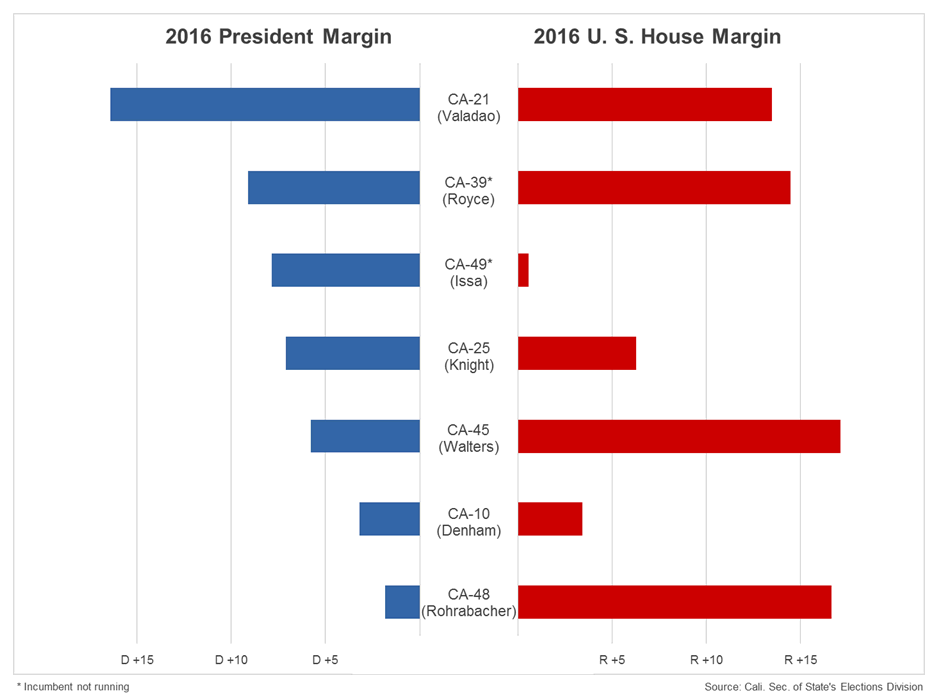A Democratic wave in 2018 will depend on results from California, which boasts seven competitive congressional contests. In 2016, Democrats failed to gain any seats here despite Hillary Clinton’s more than 30-point victory margin. There are several districts that make for promising Democratic opportunities this cycle, especially given a couple Republican retirements. However, the turnout–especially in districts with a sizable non-white population–presents a big question.
Democratic Seats to Watch
To capitalize on a positive political environment, Democrats will need to limit losses among incumbents. It is crucial for them to avoid the difficulties they faced in 2014, when five Democratic incumbents nearly lost their seats as a result of anemic turnout. The difference in turnout between presidential and midterm elections in these districts has a dramatic impact on the incumbents’ chances. In 2016, total turnout increased almost 28 percentage points across the five districts (over 2014). The increased turnout boosted support for the Democrats by approximately 10 points, even though they held a consistent registration advantage over the same period.
| 2014 | 2016 | 2018 | |||||
|---|---|---|---|---|---|---|---|
| District | Dem. Incumbent | Dem. Reg Advantage |
Dem. Victory Margin |
Dem. Reg. Advantage |
Dem. Victory Margin |
Dem. Reg. Advantage |
Dem. Victory Margin |
| CA-07 | Ami Bera | 2.3 | 0.8 | 5.5 | 2.3 | 6.3 | – |
| CA-16 | Jim Costa | 16.5 | 1.5 | 18.8 | 16.1 | 18.8 | – |
| CA-26 | Julia Brownley | 8.1 | 2.7 | 12.3 | 20.8 | 13.1 | – |
| CA-31 | Pete Aguilar | 6.1 | 3.5 | 12.1 | 12.1 | 12.6 | – |
| CA-52 | Gary Peters | -1.3 | 3.2 | 3.3 | 13.1 | 4.5 | – |
This group of Democratic incumbents will need turnout to remain closer to the 2016 level to ensure a safer path to reelection this year; none of them earned more than 52 percent of the vote in 2014. Nevertheless, our current analysis suggests that these incumbents are likely to be reelected, with the 7th and 16th district facing the most challenging campaigns.
Democratic Targets
Hillary Clinton won seven districts that are currently held by a Republican, making these the most obvious targets. Several of them are top-tier targets—especially districts 10, 25, 39, and 49—and the open-seat contests in the 39th and 49th districts offer the best chances for a pick-up.
Winning these districts is still a challenge—the Republican incumbent was reelected by more than 10 points in the 21st, 39th, 45th, and 48th districts. Moreover, turnout is chronically lower in districts where Asian and Hispanic voters comprise a significant portion of the district.
| District | Republican Candidate | Democratic Candidate | Hispanic CVAP |
Asian CVAP |
|---|---|---|---|---|
| CA-10 | Jeff Denham | Josh Harder | 29.9% | 6.7% |
| CA-21 | David Valadao | TJ Cox | 56.6% | 3.9% |
| CA-25 | Steve Knight | Katie Hill | 28.2% | 7.5% |
| CA-39 | Young Kim | Gil Cisneros* | 26.8% | 28.1% |
| CA-45 | Mimi Walters | Katie Porter* | 14.2% | 19.8% |
| CA-48 | Dana Rohrabacher | Harley Rouda | 13.9% | 18.0% |
| CA-49 | Diane Harkey | Mike Levin | 17.6% | 6.7% |
| *NCEC Supported | ||||
Still, given the political environment, it’s likely that the Democrats will flip at least three California districts in 2018, and perhaps more in 2020.

